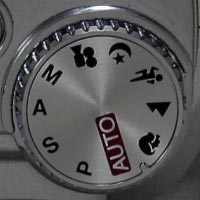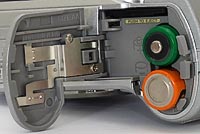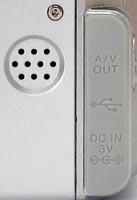Fujifilm Finepix E500
Review Date: February 10th 2005
|
Ease of Use
The Fujifilm Finepix E500 is a mid-sized digital camera that looks quite stylish in a grey and silver kind of way. It has an all-plastic design with a substantial hand-grip on the right-hand side which makes handling the camera easy. All of the external controls are thoughtfully arranged, with the main control dial sitting in the traditional place on top of the camera, and the power and shutter buttons alongside it. The rear is dominated by the large 2 inch LCD screen, with most of the controls such as the arrow pad, function button and menu button to the right of it. I wouldn't describe the Fujifilm Finepix E500 as a particularly good-looking or cutting-edge digicam, but after a couple of weeks of using it I can say that it has been designed to appeal to photographers, rather than gadget-lovers looking for the latest style icon.
The Fujifilm Finepix E500 will just about fit into a trouser pocket. Due to all that plastic, the Fujifilm Finepix E500 is a light camera at just 170g without the battery and memory card fitted, which is good if you want a camera that is easy to carry around. The Finepix E500 is generally well-made, with the principal buttons feeling responsive, particularly the mode dial which clicks from one setting to the next. The shutter button and zoom buttons work well and are not as "squidgy" and unresponsive as on some other cameras that I have reviewed recently. Another nice touch is the exposure compensation button which is located on the rear to the left of the LCD screen. Exposure compensation is a feature that you will access more often than you think as you try to prevent burnt-out highlights in your images (not that the E500 is bad at this!), and dedicating an easily accessible button is a great idea. More often than not this feature is buried in the digicam menu system.
The major drawback with the all-plastic design is that the body has quite a lot of flex, so much so that you can hear it creak if you squeeze it! This isn't as drastic as it sounds, but you should be aware that the Fujifilm Finepix E500 isn't the most substantial camera in the world in terms of the materials that have been used. When the camera is set to the wide-angle lens setting, the lens is clearly visible in the bottom right-hand corner; as the viewfinder only offers 80% coverage of the scene, you probably won't want to use it too often anyway.
| Photo Mode Button / Arrow Pad / Menu/OK Button / Back Button | Mode Dial |
 |
 |
Another aspect that departs from the camera's overall good design is the plastic cover for the AV Out, US and DC In ports. There is usually a plastic lug in one corner which prevents the cover from falling off - not so with the Fujifilm Finepix E500, the whole cover just comes off when you want to access any of the 3 ports underneath. It didn't actually fall off during the review period, but if it did you probably wouldn't notice, and the ports would then be left unprotected.
Another area that the designers haven't quite got right is the pop-up flash. The flash unit can be closed without actually being pushed down as far as it will go - it can be left slightly raised above the top of the camera, rather than flush with it as it should be. The final design feature that I didn't take a shine to was the battery compartment cover. You will open and close this quite a lot, as the xD Picture Card slot is also located here, but unfortunately the cover is fiddly to close. It's more annoying than anything else.
Like virtually all digital cameras the Fujifilm Finepix E500 has a Menu button on the rear of the camera which, as you would expect, gives you access to the software menu system. This lets you set various parameters including focusing, sharpness and white balance. As with most other Fujifilm digital cameras, there is also a blue F button (the Photo Mode button) which is positioned to the right of the LCD screen. Pressing this button opens the Photo Mode menu, which allows you to set the file quality, ISO speed and colour settings (B&W, Chrome or Standard). I'm not really sure why these 3 settings alone should fall under the heading of Photo Mode, and things like white balance and sharpening are just part of the standard menu. And I'm undecided about whether it is a good idea or not. The F button does give quick access to certain features, but you do have to memorise what another button does.
| Battery Compartment | Speaker / A/V Out Port / USB Port / DC In Port |
 |
 |
The main menu system is as well designed as previous Fujfilm digicams that I have reviewed. There is a horizontal row of icons along the bottom of the screen, which when selected reveal the options for that particular function, which you then access by scrolling up and down. Very easy to see and access. In addition to the Exposure Compensation and Photo Mode buttons mentioned above, there are a couple of other features that you won't find in the main menu, which are accessed by pressing the left and right arrows on the arrow pad. These are the macro and flash functions.
The start-up time of the Fujifilm Finepix E500, from turning the camera on to being ready to take a photo, is about average for more recent digital cameras at around 1 second. The 3x zoom lens takes less than 1 second to zoom from the widest focal length to the longest. The zooming mechanism is also not too noisy, bordering on discretely quiet. Focusing, confirmed by a green LED next to the optical viewfinder, is very quick in good light, but the camera struggled to achieve focus indoors or in low-light situations. The LCD screen is bright and clear and the refresh rate noticeable but perfectly acceptable. It takes about 0.75 seconds to store an image and the E500 has no continuous shooting or focusing modes, so it isn't suited for action photography. All in all the Fujifilm Finepix E500 is average in terms of general operational speed, but not a good choice for taking photos of anything that moves quickly.
Once you have captured a photo, the Fujifilm Finepix E500 has an above average range of options for playing, reviewing and managing your images. You can scroll through the images that you have taken, view thumbnails, play slideshows with various effects, and zoom in and out of the image up to 14x magnification. You can also add an audio clip to each image, delete an image, trim an image, lock images so that they cannot be deleted, and set various printing options. The most important missing feature is a histogram (both before taking a photo and after) which would be a great help in evaluating the exposure.
After using this camera for a couple of weeks, I am left with the impression that the Fujifilm Finepix E500 is an intuitive camera that will suit the photographer who wants full creative control. It does have some build-quality issues and is not well-suited to action photography.
|
 PhotographyBLOG is a member of the DIWA organisation. Our test results for the Fujifilm Finepix E500 have been submitted to DIWA for comparison with test results for different samples of the same camera model supplied by other DIWA member sites.
PhotographyBLOG is a member of the DIWA organisation. Our test results for the Fujifilm Finepix E500 have been submitted to DIWA for comparison with test results for different samples of the same camera model supplied by other DIWA member sites.
